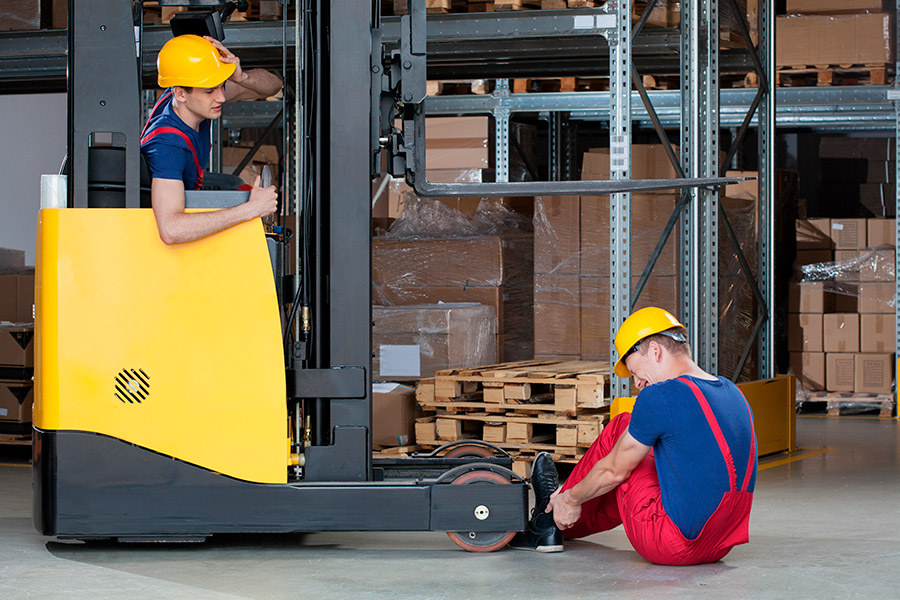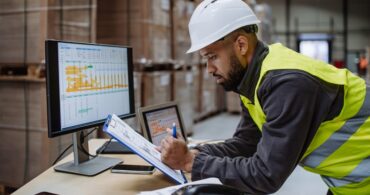Type the term “forklift accident” into a search engine, and the first thing that pops up is several videos of pallets crashing and trucks tipping. Some videos are even set to wacky music. However, the one thing that all these “forklift fails” videos have in common is that there’s nothing funny about them.
There’s nothing funny about fork truck accidents (well, maybe this one, because it’s an accident that happened to a forklift, and no one was near to be hurt). According to the Occupational Safety and Health Administration (OSHA), there are approximately:
- 85 fatal forklift accidents per year.
- 35,000 reach truck accidents with serious injuries.
- 62,000 non-serious accidents.
The main reason these videos are not entertaining is that, in many of them, there is no way to ensure someone was not seriously injured. Watching a “forklift fail” video is like watching a horror movie. As a viewer, you can see the danger, but the people on the screen continue about their business, seemingly unaware of the threat. Except in many cases, they were acutely aware of the risks (sometimes people can be heard advising the operator to stop). In most cases, the accident could have been avoided by exercising more caution or through collaboration and teamwork.
There are several reasons that forklifts become a potentially fatal workplace hazard when misused. Warehouse forklifts can weigh up to 9,000 pounds, three times heavier than the average sedan. They can reach up to 18 miles per hour and, unlike a car, forklifts only have brakes in the front, making them harder to stop. Also, forklifts carry much of their weight in the rear, to compensate for the heavy loads carried in front. This uneven weight distribution can make a forklift challenging to handle.
Let’s take a look at what are the main causes of injuries when using forklifts and some ways to avoid them.
What is the most common type of lift truck accident?
Forklift rollovers
According to the CDC, “Forklift overturns are the leading cause of fatalities involving forklifts; they represent about 25% of all forklift-related deaths.”
Forklifts are known as “counterbalanced” vehicles because they are constructed with a great deal of weight located in the rear, much or all of it due to the heavy battery that powers the vehicle. In fact, most forklifts weigh nearly twice their rated carrying capacity.
Counterbalanced forklifts utilize a three-point suspension system that helps distribute the vehicle’s weight. The area formed by the three points of the suspension is known as the stability triangle. As long as the vehicle’s center of gravity remains within the stability triangle, the forklift stays balanced. However, once the center of gravity passes outside the stability triangle, the forklift is at risk of tipping over and causing a forklift crash.
Many activities could cause the center of gravity to move outside of the stability triangle and cause a rollover, including:
- Driving with a load elevated too high.
- Carrying an uneven or unbalanced load.
- Using excessive speed.
- Turning too quickly.
- Turning on an incline.
- Driving on uneven surfaces.
Avoiding forklift rollovers
One of the main ways to avoid a forklift rollover is to drive at an appropriate speed. Not only does maintaining a reasonable speed help avoid sharp turns, but it also gives operators more time to react to unexpected events and uneven ground (potholes and bumps throw off the vehicle’s center of gravity). Fortunately, moderate speeds are becoming the norm in warehouses because many manufacturers allow employers to set speed limits on their lift trucks.
However, even when moving at an appropriate speed, operators should always slow down before attempting a turn. A forklift uses its rear wheels to turn, which means the back of the vehicle swings out. Taking any turn too fast can cause the center of gravity to move outside the stability triangle, which puts the vehicle at risk of turning over. Also, never turn on an incline. Always travel to the length of the slope first, then turn.
When transporting a load, always make sure it is within the vehicle’s lift capacity and never move a load or the mast when the vehicle is moving. Before traveling, ensure the load is centered and travel with it as low to the ground as possible. Also, always stay within the maximum load capacity. Transporting a heavier load than the forklift is designed to carry makes the vehicle more likely to tip.
Should an accident occur, and an operator feels a forklift start to tip over, they should not attempt to jump out. Jumping out increases their chances of getting caught under the machine. Instead, they should stay buckled into the seat, grip the wheel tightly, brace their feet and try to lean in the opposite direction of the fall. Following these guidelines will help prevent both forklift injuries and forklift fatalities.
Pedestrian accidents
Forklifts consistently operate with workers in the same vicinity. If just one person loses focus, the potential for a severe accident is significant. According to OSHA’s forklift pedestrian accident statistics, 20 percent of forklift accidents involve pedestrians either being struck by forklifts or struck by objects that are dropped or knocked over by forklifts.
The main reasons forklift pedestrian accidents occur are distracted or inattentive drivers and a lack of warning signage and signals in the work area.
Averting pedestrian accidents
Forklift operators are more likely to become distracted when they are tired. OSHA found that workers who work 12-hour shifts are 37% more at risk of injury. Drivers who work long shifts without regular breaks are dangerous to themselves and other workers. Providing workers with frequent breaks and ensuring they get enough downtime helps foster a safe work environment.
Next, restructure the floorspace by posting warning signs in high-traffic areas and designating forklift zones with floor tape. For sites with heavy traffic of both pedestrians and forklifts, installing physical safety barriers will help keep everyone secure.
Falling containers
Typically, when a forklift carries a single pallet, it is easy to ensure the weight is evenly distributed. However, if the load is uneven or contains more than one box, the containers may become unbalanced and create a dangerous situation.
Improperly loaded cargo poses a hazard to forklift operators and anyone in the vicinity. Not only can a heavy load seriously or fatally injure a driver or pedestrian, but contents such as gasoline, pesticides, paint and other hazardous materials can be harmful if they hit the air or touch someone’s skin.
The most common reasons a container could fall from a truck include:
- Carrying a load that’s off-center, damaged or loose.
- Moving, lifting or tilting the mast too fast.
- Damaged forks.
Preventing falling loads
Once a container is loaded, take time to ensure that it is centered and secure on the tines. If it is impossible to center a container, ensure its heaviest part rests against the carriage. Use shrink wrap or bands to fasten the cargo to the forklift if necessary.
Always use caution when tilting the mast. Moving it too quickly could cause a jerking movement that can disrupt cargo and lead to a fall.
Also, before every shift, operators should thoroughly inspect their forklifts. That review should include the tines to ensure they are straight and undamaged. Damaged forks could cause even a perfectly centered load to dislodge and fall.
Forklift falling to a lower level
This type of event is frequently featured in those “forklift fail” videos, and it looks very scary each time. It turns out that crossing a threshold, such as in and out of tractor-trailers, is a risky activity for a forklift operator.
The leading causes of lower-level falls are:
- Trucks or trailers rolling away.
- Slippery floors.
- Worn or damaged floors.
Avoiding lower-level falls
Before driving into a tractor-trailer, it is essential that a forklift operator communicates with the driver of the semi to ensure the tractor stays in place. It may also be helpful to place blocks behind the tractor-trailer’s tires to ensure it does not move as the forklift drives aboard.
Also, a forklift operator always needs to be aware of their surroundings. This includes watching for spills and liquids on the ground and checking for missing sections of flooring and uneven surfaces.
Driving into storage racks or knocking a pallet loose
Another frequent feature in the “forklift fails” videos, accidentally driving into storage racks is also one of the most easily preventable forklift accidents. No one wants to be the employee who causes thousands of dollars in damage and lost product by knocking down a shelving unit or two. By driving at an appropriate speed, taking care when turning and watching for obstacles, a forklift operator should remain safely in their lane and away from the storage racks when moving.
Accidentally dislodging a pallet is surprisingly easy. Whether it’s by accidentally bumping into a rack or, more likely, mishandling a pickup from a high rack. It is challenging for an operator to see the containers on the higher shelves. Ensuring a load is correctly positioned on the forks is even more difficult.
Preventing knocking a pallet loose
Technology can give operators a significant advantage. Today, many forklifts are equipped with a camera on the lift carriage to help guide the forks. For forklifts without a camera, teamwork is the best solution. Operators should grab a coworker or two and use them as spotters.
Should a forklift operator find themselves in a situation where debris falls on their vehicle, the safest step is to remain in the forklift. The canopy is there to protect the driver. It may feel not ideal, but it’s much safer than moving into an immediately dangerous situation.
Inadequate operator training
OSHA estimates that approximately 70% of all fork truck accidents could be avoided with proper safety training.
OSHA also mandates training and certification for every forklift operator. So, the problem isn’t that forklift operators are untrained. (At least, that shouldn’t be the problem. Seriously, anyone working for a business that does not require its employees to be trained to use heavy equipment, run.)
However, as people become comfortable with their role, it is human nature to become complacent and even over-confident. It is not uncommon for once rigorously adhered to safety practices to accidentally go by the wayside.
Overcoming inadequate operator training
Businesses need to stress both training and retraining. Reinforcing OSHA-approved safety standards will lead to increased compliance and a safer workplace.
So, whether you say forklift accidents, fork truck accidents or tow motor accidents, they all mean the same thing, and that’s something to avoid. Creating a safe workplace environment is everybody’s responsibility. For further thoughts on how to prevent a forklift accident or to discuss your forklift battery and forklift accessory needs, please reach out to our forklift repair service team at (888) 316-2459. You can also fill out this form to learn about our services and discover everything we can do for you.



